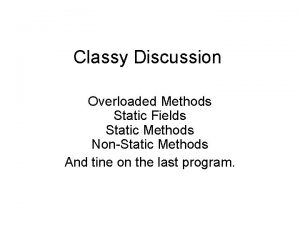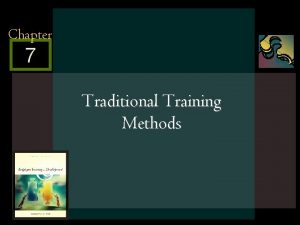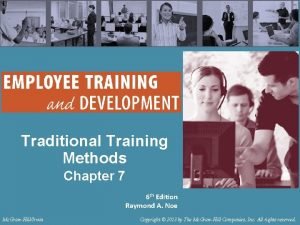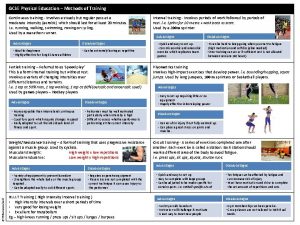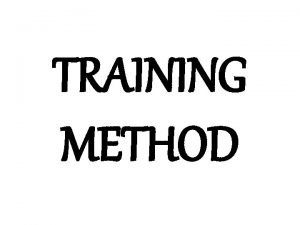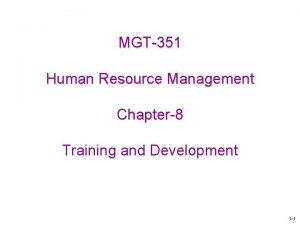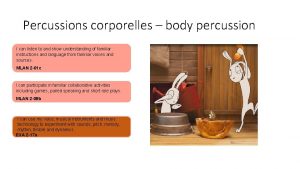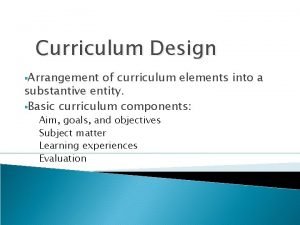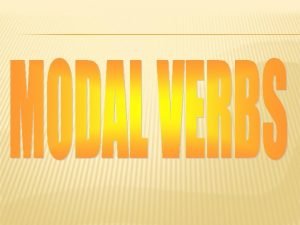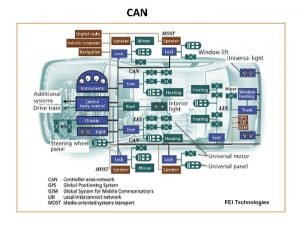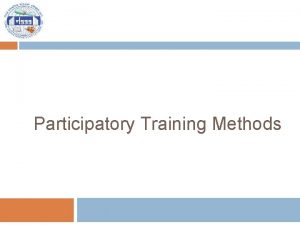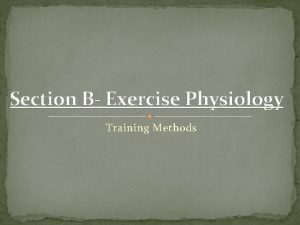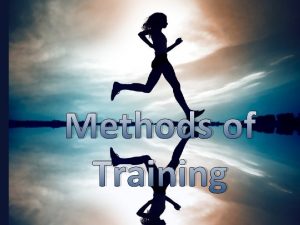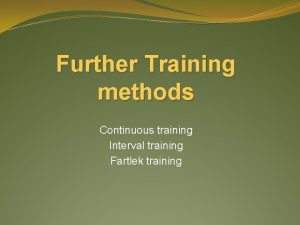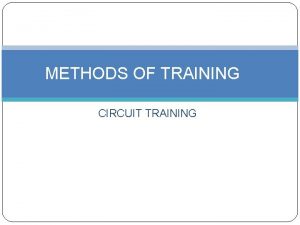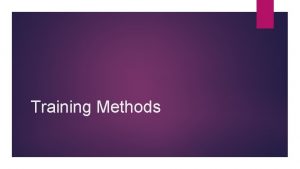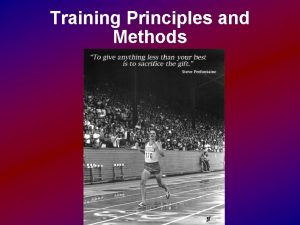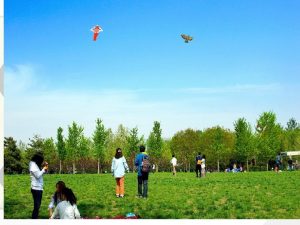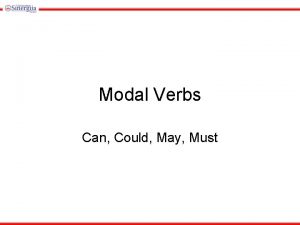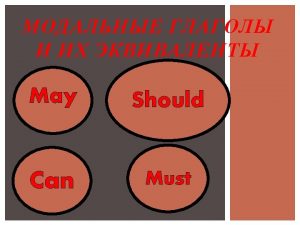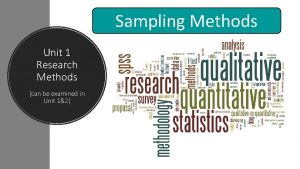METHODS OF TRAINING 8 METHODS OF TRAINING CAN






















- Slides: 22

METHODS OF TRAINING

8 METHODS OF TRAINING… CAN YOU NAME THEM? 1. 2. 3. 4. 5. 6. 7. 8. Interval Continuous Fartlek Circuit Weight Plyometrics Flexibility SAQ

Make an acronym to help you remember: PFFWICCS � Peter � Forward � Flipped � With � Indigo � Coloured � Carrot � Sticks

PLYOMETRIC TRAINING – � Plyometrics also known as "jump training" or "plyos", are exercises in which muscles exert maximum force in short intervals of time, with the goal of increasing both speed and power. � Example Plyometric Training Who uses it? Sprinters Body Builders Athletes: Basketball , Volleyball, Football players etc

FARTLEK TRAINING � The word Fartlek is Swedish and means ‘speed play’ � Combines high and low intensity work � Involves many changes of speed and terrain � Improves speed and endurance (CV) Who uses it? � Games players because short bursts of speed – starting, stopping and sprinting � To overload increase the time or speed for each activity or choose more difficult ground. E. g. running uphill or on sand.

FLEXIBILITY/MOBILITY TRAINING – � � � Improves Range of Motion and Athletic Movements Injury Prevention Injury Recovery A flexibility training program can be made up of different types of stretching: 1. Dynamic Stretching 2. Ballistic Stretching 3. Static Active Stretching 4. Static Passive Stretching 5. Isometric Stretching 6. PNF Stretching � � Which type of flexibility training is best? It depends on the sport and the athlete's outcomes - something which will be examined more closely in the articles below. As a general rule, dynamic stretches are used as part of a warm up and static stretches or PNF flexibility training is used for increasing range of motion. Who uses it? EVERYONE! Gymnasts

WEIGHT TRAINING - STRENGTH � Resistance training Is used to 1. Increase muscular strength 2. Increase muscular endurance 3. Increase speed 4. Develop muscular bulk (size) 5. Rehabilitate after injury Who uses it? Athletes, swimmers, games players and others Apply individual needs to suit

INTERVAL TRAINING – � Periods of hard work followed by periods of rest. � Improves mainly speed, will also improve CV. � High intensity and fast pace. 1 Rep = Sprint for 60 m, rest for 30 seconds 1 Set (of repetitions) = 4 xruns and rest. ‘Rest’ might mean milder exercise e. g. 30 m sprint 30 m slow jogging. � � The ‘Rest’ periods give us time to recover. Who uses it? Sprinters (Athletics, Swimming, cycling)

CIRCUIT TRAINING �A circuit is made up 6 – 10 exercise or skills stations at which a particular activity is performed. � Circuit training develops: - All round fitness - CV and ME fitness

CONTINUOUS TRAINING - CV Improves aerobic fitness � Is also good for people who have not trained for a long time. (unfit) Brisk walking � Moderate exercise for at least 15 -20 mins no rest. Who uses it? � Endurance athletes (Long distance events) � Games players (Pre season) Running, Swimming, Cycling and Rowing Overload is achieved by increasing the time, distance and speed.

SAQ (SPEED, AGILITY, QUICKNESS) TRAINING � Improves Acceleration and Deceleration � Improves Balance, Power and Neuromuscular Firing Patterns Many game sports (eg football, rugby, hockey) involve a mix of intermittent, dynamic and skilled movement activities. This poses a problem for coaches and staff as to how they train the players to achieve the correct balance of fitness. Who uses it? Athletes (each is specifically tailored to Their retrospective sport)

1. 2. 3. 4. 5. Name the 8 types of training. Name 3 exercises you could include in a circuit designed to improve muscular endurance. What type of training improves cardiovascular fitness – explain. What is interval training? What is fartlek training and why is it good for games players.

1. How can we determine which type of fitness is improved? TYPE of activity TIME spent at each activity NUMBER of stations and circuits completed. How do we increase the difficulty in a circuit? If we want to improve leg power and cardio vascular fitness – What type of exercises would we include in a circuit?

� What happens if you use several methods of training? � This is a new type of training called: ….

�A mixture of training methods � Who? Used for most sports � E. g. Circuit training and interval training for Football CV and ME fitness. Advantages? � Allows for a variety of training � Makes training more interesting � Training can be adapted to weather � Can rest different muscle groups from day to day.

HERE ARE SOME HELPFUL SLIDES TO GIVE YOU MORE INFORMATION ABOUT THE DIFFERENT METHODS OF TRAINING

A TYPICAL FARTLEK SESSION � Jog for warm up – 8 min � Sprint every other lamp post – 8 posts � Jog recovery – 5 mins � Sprint 10 paces – 10 reps � Recovery – 30 secs � ¾ pace for 30 sec – 6 reps � Jog recovery – 1 min � Jog to finish – 10 mins

Can develop muscular strength, muscular endurance and power. . . � Max strength = 3 sets of 6 reps at near max weight. � Muscular endurance = 3 sets of 20 -30 reps. � Muscular power 3 sets of 10 -15 reps. Can use a variety of exercises to work on specific muscle groups Is easy to monitor progress and overload.

Who uses it? Games players, swimmers Advantages? Not much equipment needed Not expensive Can be done at home or at the gym Uses music – motivational Fitness and skills

Station 1 Station 8 Station 2 Station 7 Station 4 Station 6 Muscular Endurance Cardiovascular Fitness Station 5

Advantages? � Improves aerobic fitness � Cheap � Can be done individual and in a group � Improves health and fitness � Can be done anywhere � Adapted to suit individual needs � Range of activities can be used (Running, Swimming, Cycling, Rowing, Cross trainer) � Can easily apply the FITT principle

� Improves � Can speed and endurance be done over a variety of terrain (Beach, Countryside, Park) � Can include hill work and reps � Programmes � Suits can be flexible games players
 A-wax pattern recognition
A-wax pattern recognition Can static methods be overloaded
Can static methods be overloaded Specific purpose statement
Specific purpose statement Traditional training methods
Traditional training methods Traditional training method
Traditional training method Methods of training pe
Methods of training pe Circuit training methods
Circuit training methods Circuit training advantages and disadvantages
Circuit training advantages and disadvantages Methods of training in human resource management
Methods of training in human resource management Methods of training
Methods of training Employee training methods
Employee training methods Programmed instruction
Programmed instruction If you can imagine it you can achieve it
If you can imagine it you can achieve it You can tell harris about it just ____(easily) as i can.
You can tell harris about it just ____(easily) as i can. If you think you can you can poem
If you think you can you can poem If you cant measure it you cant manage it
If you cant measure it you cant manage it If you can't measure it you can't manage it
If you can't measure it you can't manage it Percussions corporelles
Percussions corporelles Arrangement of element of curriculum is known as
Arrangement of element of curriculum is known as You can tell harris about it just ____(easily) as i can
You can tell harris about it just ____(easily) as i can Comparative and superlative for less
Comparative and superlative for less You can speak english
You can speak english Look at the pictures and complete with can or can't
Look at the pictures and complete with can or can't

